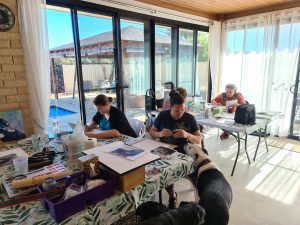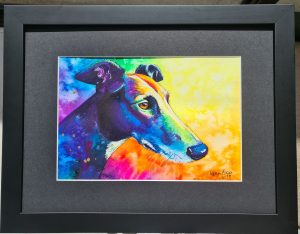“Paint your pet in Watercolour,” held in May 2023, was once again a very successful workshop. A beautiful weekend was forecast so the stretching paper demo was able to dry quickly. I usually have about 4 workshops per year, since the completion of my home studio, I can hold these for about 6 people.
The workshops are split into two days, the first day is a demonstration of the drawing techniques required. I teach enlarging from a photograph using a simple acetate grid. This is such a handy technique to master as you can not only enlarge but reduce in size too. The simple formula works for simple enlargement of A4 to A3, or even up to the side of a house if necessary!
I demonstrated a couple of images, a black greyhound and a black Red Tailed Cockatoo, the main aim of these workshops is to show how warm and cool colours can be used to create the portraits. Warm colours depict the highlights and cool colours depict the shadows. I chose to demonstrate a bright Rainbow background, and a more natural tonal effect.
The colours I use never change, Lemon Yellow, Australian Red Gold, Bengal Rose (Gouache), Phthalo blue, Bamboo Green (Holbein brand is the nicest blue green I have found as it is bright and beautifully transparent), Indigo and Dioxazine Purple. Most of these colours can be found in either the Cotman tube ranges (which I recommend for beginners as they are lovely, clear colours, but a cheaper version than the artist quality brands), or the Windsor & Newton range, the other brand I like to use is Art Spectrum, I use tubes of paint verses the pans, as the technique requires large coverage of areas in a short time frame. The final touch is a small amount of titanium white gouache, brilliant for the dots in eyes or stray white hairs, unlike the Chinese White watercolour, which I find is more of a milky glaze than a bright white.
Day 1
Once the outline is drawn with as much detail as possible, we move on to the background. The warm colour area depicts the light source. It is important not to mix certain colours such as the green and Bengal rose as they go very muddy, not a nice combination, therefore care and thought are needed when placing colours together. I tell the students to think about what colour mixes to what, to get the next colour, for example yellow to red (in this case the Bengal Rose) gives you the oranges.
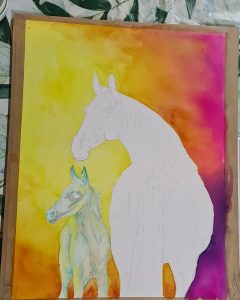
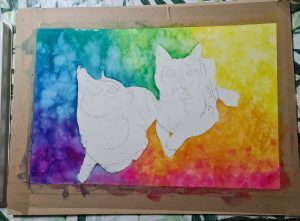

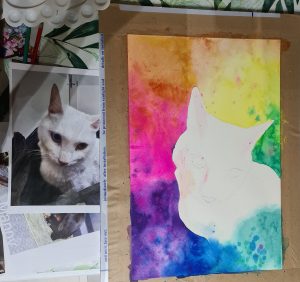
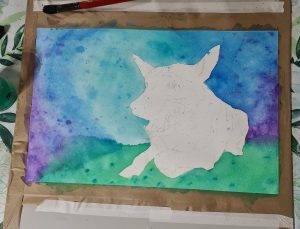
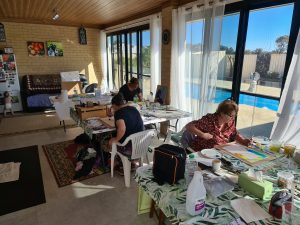
Day 2
Day two is the fun bit, the actual painting of the subject. The students all did such a great job of their backgrounds, and its not as easy as it looks! There are several different ways of painting with watercolours, the main two are wet on wet and wet on dry, the background is the wet on wet, but other things affect the process, such as the weather, too hot and it dries way too quickly, to humid or damp and the water takes too long to dry leading to muddy blending. The splashes of paint, that help to blend the colours, are added in several layers as the paint dries. I teach several effects at this stage, if you want to know more….. book into a workshop!


How awesome are these!
All the examples of finished work are amazing, they should be very proud of their work. .
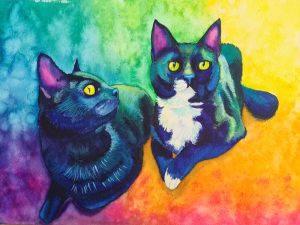
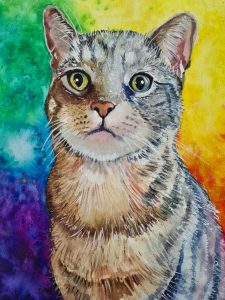
Even though there is a common theme, everyone’s piece is so different. If the student doesn’t want a really bright image, the colours can be toned down or used in other ways and yet still look “Normal” to the eye. It’s amazing how the eye and brain evaluate the images. You almost don’t notice the bright green or pink that are subtly used in the subject on first glance.

Sadly one of the students couldn’t complete her second day, so I finished her painting off for her, she had made such a tremendous start it seemed unfair that she go home with only half a dog, and it was another example for me to demonstrate.


I use my images reverted into monochrome as examples to show how the colours really look as tones. This is why the brain usually accepts them as a “Black dog” instead of a “blue and yellow dog”. I know which of the paints I use have similar tonal values when dry, so I can swap out the Phthalo blue with green, or the magenta with purple.
By the end of the weekend there has been some amazing art created, each one unique, and everyone seems to take away something different from the experience, whether it be a new skill, or a new understanding of colour.
I just hope that they all take away a memory of a fun weekend, trying something new, if they change their colour palette that’s Great! If they realise what colours can/can’t be mixed that’s great too. I hope they go away with new ideas and a fun take on a technique. It’s all about learning and enjoying the experience…. having a dabble in a safe space.
There’s no right and wrong with art, just a different perception.


